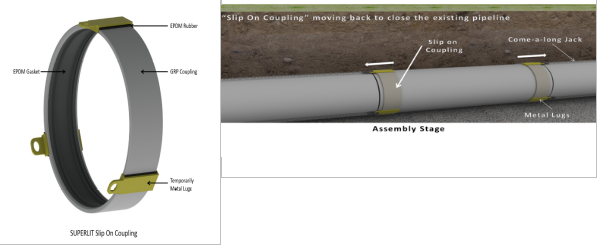GRP Pipe Services

Liquid Energy Global Services Limited , is very competent in GRP pipe works , both repairs and installation.
Today’s life without GRP (glassfiber reinforced plastics) would be difficult to imagine. Discovered for industrial purposes around the beginning of the 20th century, the material has initially been used for insulating houses. Further applications quickly evolved, and today the material is commonly used in the aerospace, automotive, marine, and construction industries.
What it’s made of
Glass(fiber) Reinforced Plastic (GRP) is a composite material that consists of a polymer matrix and glass fibers. The polymer matrix is usually an epoxy, vinylester, or polyester thermosetting resin. The resin brings the environmental and chemical resistance to the product, is the binder for the fibers in the structural laminate and defines the form of a GRP part. The glass fibers add strength to the composite. They may be randomly arranged, or conveniently oriented. The most common type of glass fiber used for GRP is E-glass, which is alumino-borosilicate glass. E-CR-glass (Electrical/Chemical Resistance) is also commonly used in applications that require particularly high protection against acidic corrosion.
Why it’s so strong
As with many other composite materials, the two materials supplement each other to form a stronger compound. Plastic resins are strong in compressive loading; the glass fibers are very strong in tension. By combining the two materials, GRP becomes a material that resists both compressive and tensile forces very well. Production methods of GRP include filament winding, centrifugal casting, hand lay-up and spray lay-up, and pultrusion.
What the superior advantages are

GRP features many beneficial characteristics. It comes with low weight at high mechanical strength, resistance against chemicals and corrosion (thanks to its non-conductive properties also electrolytic corrosion), UV radiation and temperature stability, and environmental friendliness. GRP is waterproof, making it ideal for all outdoor applications. It can be customized to be fire-retardant by using non-flammable resins. GRP is a highly durable material with a very long lifetime expectancy, ideally suited for a wide range of applications in various industries.
GRP in pipeline construction
Since the 1950s, GRP has gained a firm foothold in the construction of pipelines. The range of applications covered by GRP piping solution today is broad: from sewer systems and potable water lines to storage tanks, drainage pipes, hydropower penstocks, industrial pipe systems, as well as rehabilitation solutions with special non-circular pipe profiles, to name just a few. The methods by which the pipes can be installed are just as manifold and include open trench, above ground, on suspensions, underwater, and by means of trenchless technologies such as relining and microtunneling.












